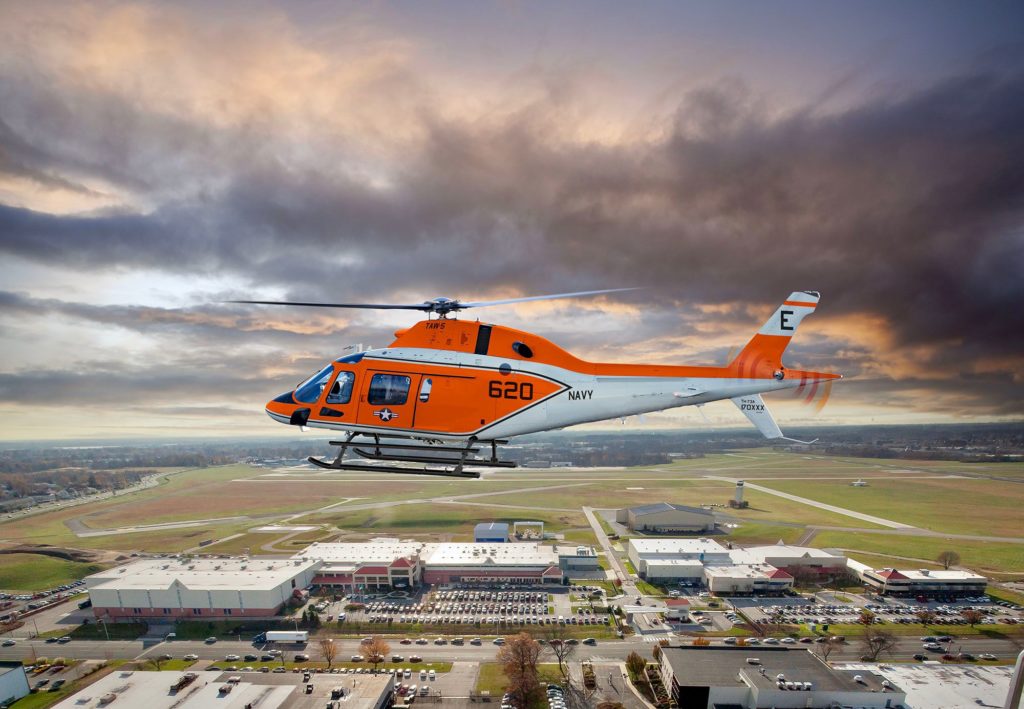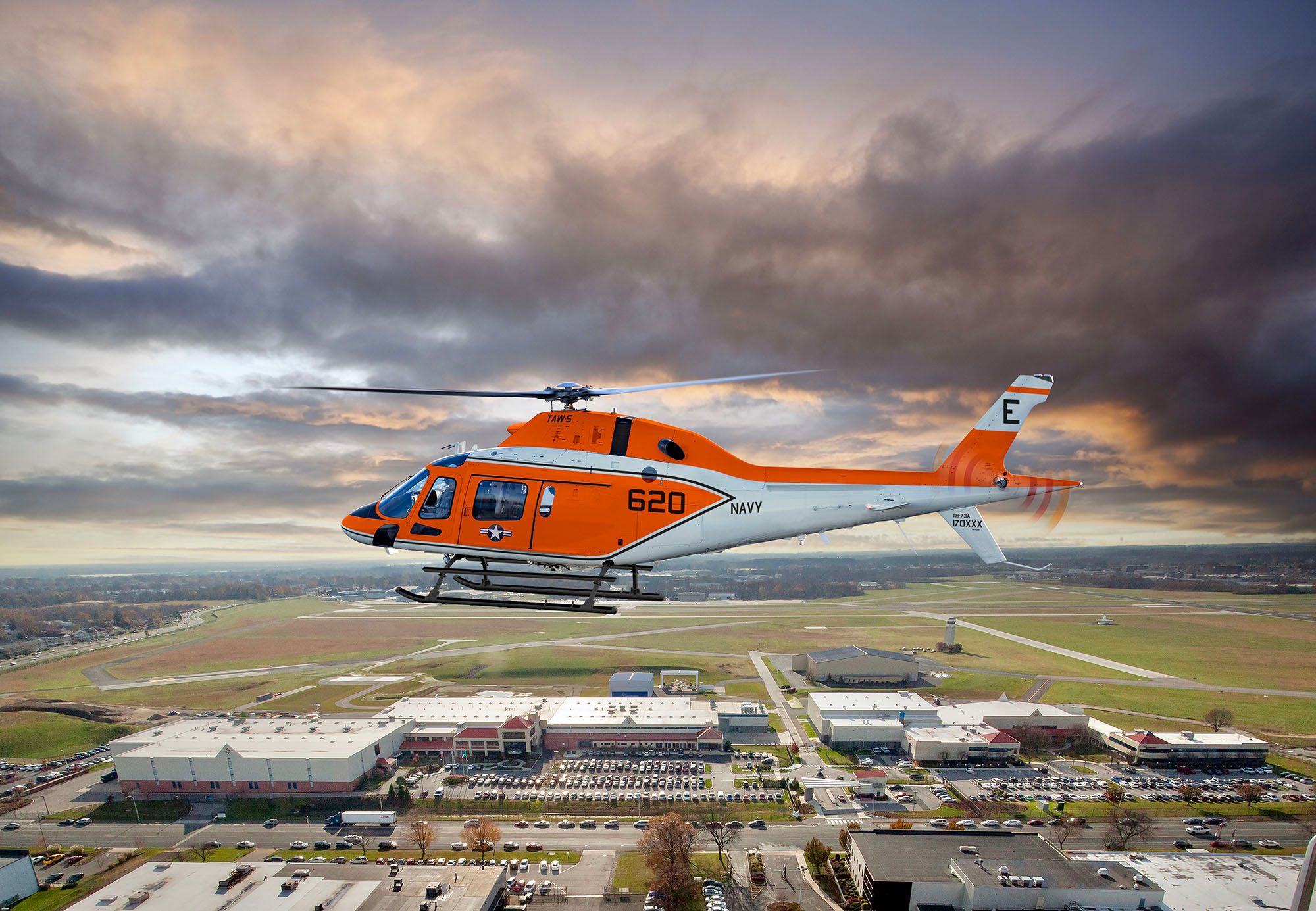Leonardo today officially delivered the first TH-73A training helicopter to the U.S. Navy, which plans to buy 130 of the helicopters to replace the aging TH-57 Sea Ranger.
Hampered by a 100-day protest by Airbus of the initial contract award and a global pandemic that disrupted supply chains since day one, Leonardo Helicopters was able in just 18 months to deliver the first helicopter during a ceremony at its Philadelphia facility on June 10.

The ceremony was attended by Vice Adm. Kenneth Whitesell, commander of Naval Air Forces and Naval Air Force U.S. Pacific Fleet, Director of Air Warfare Division Rear Adm. Gregory Harris and Capt. Holly Shoger, program manager of the Naval Undergraduate Flight Training Systems program.
Leonardo Helicopters Managing Director Gian Piero Cutillo flew in from Italy for the ceremony, which also featured local, state and federal elected officials, including Congressman Donald Norcross and Philadelphia Mayor Jim Kenney.
Cutillo’s attendance underscores the importance Leonardo places on its status as a new U.S. military helicopter supplier. It also was chosen, along with prime contractor Boeing, to build the Air Force’s new MH-139 Grey Wolf helicopter, a double coup for a company that had tried in the past and failed to break into the U.S. military market.
Cutillo said “the U.S. Navy expects the highest quality of training for its future aviators.”
“We are honored to start delivery of the product chosen for this critical task,” Cutillo added. “Today is just the beginning of a journey we have undertaken to support the Navy as it shapes the capabilities of future generations of aviation students.”
Leonardo CEO Alessandro Profumo said the event “marks a significant milestone for Leonardo, marking our growing effort and commitment to becoming not just a supplier, but a partner and strategic asset for the United States in several sectors. We are proud to be a core contributor to the future of U.S. defense.”
The Navy’s total requirement for TH-73s is 130 aircraft with delivery to continue through 2024. The initial, firm-fixed-price contract of $177 million awarded in 2020 called for the production and delivery of the first 32 TH-73A helicopters, initial spares, support, dedicated equipment, in addition to specific pilot and maintenance services. In November 2020, the U.S. Department of Defense exercised options for an additional 36 aircraft in a $171 million follow-on fixed-price-contract.
“This is a great day for Leonardo and Philadelphia. Producing the aircraft that will train our nation’s future Naval Aviators is more than just an honor, but also a humbling and extremely gratifying experience,” said William Hunt, chief executive officer of Leonardo Helicopters in the U.S. “I am proud of the hard work that our teammates in the U.S. have given to get us to this first delivery and the many that will follow.”
The Navy expects 32 total aircraft delivered by the end of 2021, according to Andrew Gappy, Leonardo’s TH-119 program manager. At least 36 each will be delivered in 2022 and 2023 and 24 to finish off the program of record in 2024. Leonardo has 15 more in some stage of production in Philadelphia, Gappy said.
“There are a lot of orange-and-white aircraft on our line right now,” Gappy said. “With that kind of production, there is a lot of pressure on aircraft one and after that things start to pick up fairly quickly. … This year it’s pretty compressed because there just aren’t that many months left, but steady state production is three a month.”
The TH-73A is replacing the Navy’s aging fleet of Bell-built TH-57B/C Sea Rangers, and will serve as the first training helicopter for thousands of naval aviation student pilots at Naval Air Station (NAS) Whiting Field in Milton, Florida, where all student helicopter pilots for the Navy, Marines and Coast Guard train along with several NATO-allied nations.
To support this new fleet, Leonardo has announced the construction of a new comprehensive 100,000-square-foot (9,290-square-meter) helicopter support center at Whiting Aviation Park, located directly across the runway from Whiting Field for immediate maintenance and repair support, with groundbreaking expected in December.
Aside from a new IFR-certified Genesys Aerosystems’ avionics suite, to create the TH-73 from its commercial progenitor, the AW119, Leonardo installed an auxiliary generator that “enhances the capability of the aircraft quite a bit” without adding any significant weight to the aircraft, Gappy said. The company was able to fast-track certification of that configuration, which allows for emergency backup power for a limited period in the event of a main-engine failure, because it has an existing AW119 customer that flies with that configuration, Gappy said. The final FAA stamp of approval for the upgrades made to the TH-73 was made just before the handover ceremony.
While the Navy likely won’t begin training pilots on the new aircraft until next spring, Leonardo has started training the instructors who will teach them. Using two company owned TH-119s, Navy instructor pilots have flown 9,000 training hours at Whiting Field in Florida, the Navy’s rotorcraft flight training headquarters.
The Covid-19 pandemic began to take serious hold in the United States about the time Leonardo was issued the initial TH-73 contract. Leonardo felt the impact of Covid but was undeterred and is now running at 75 percent on-site capacity with administrative staff still working remotely. Production and repair operations are at 100 percent, according to Michael Cooper, a company spokesman based in Philadelphia.
“We did very well during the pandemic, but I won’t say we were without impact because obviously it impacts our suppliers,” Gappy said. “We never had to stop production, but it certainly slowed some things down. … All that went on and we still are delivering the first aircraft inside of 18 months from contract award and it’s going to be a steady flow of aircraft from first aircraft on.”









